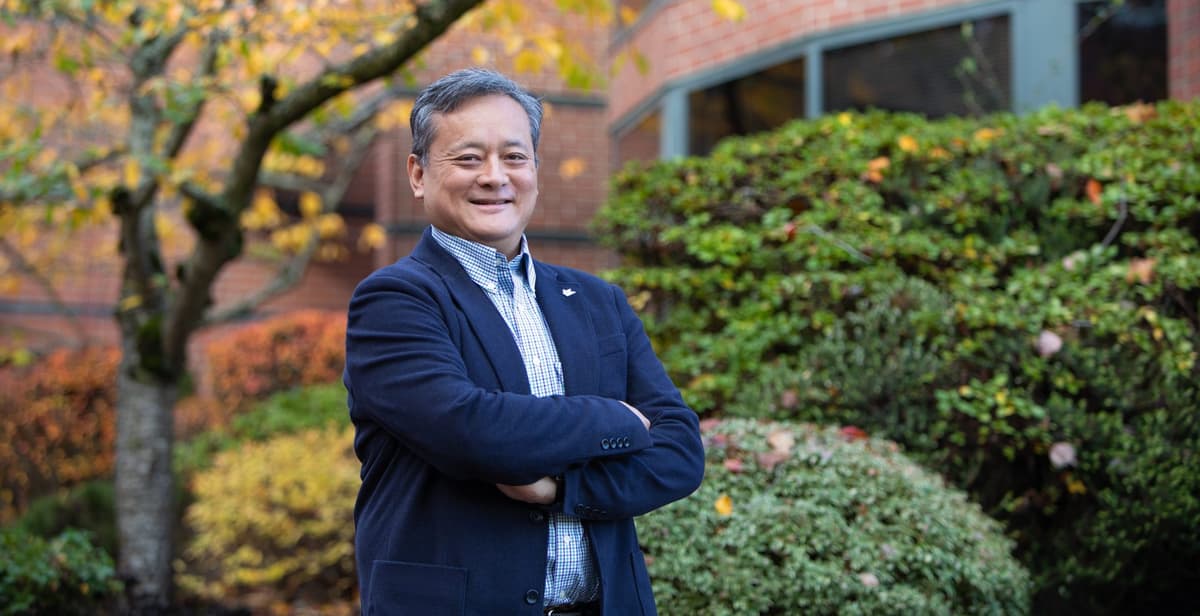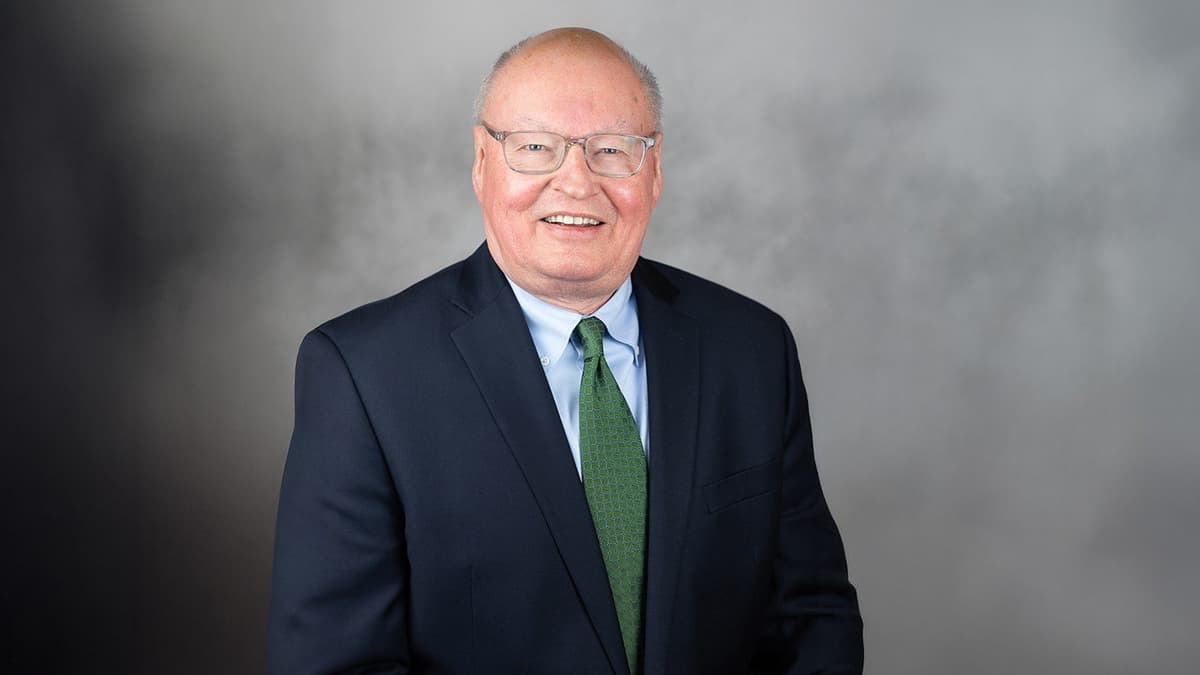The first time I met Eugene H. Peterson, everything seemed backward.
 In March 2008, by invitation of the Chrysostom Society, I found myself at a podium, a newly published novelist nervously speaking to an audience of world-renowned authors — Richard Foster, Luci Shaw, Scott Cairns, and founder and then-editor of Image journal Gregory Wolfe, to name a few — whose collective library of work had inspired me through high school, college, and beyond. The society, founded in 1986, regularly assembles Christian authors to fellowship, share works in progress, offer criticism and counsel, and strike up creative collaborations.
In March 2008, by invitation of the Chrysostom Society, I found myself at a podium, a newly published novelist nervously speaking to an audience of world-renowned authors — Richard Foster, Luci Shaw, Scott Cairns, and founder and then-editor of Image journal Gregory Wolfe, to name a few — whose collective library of work had inspired me through high school, college, and beyond. The society, founded in 1986, regularly assembles Christian authors to fellowship, share works in progress, offer criticism and counsel, and strike up creative collaborations.
I wanted to say, “I’m not worthy,” and insist that one of them take the podium to make better use of our time together. In particular, I wanted to hear from the attentive, smiling man in the first row: the scholar, author, and pastor responsible for the paraphrase translation of the Bible The Message (NavPress, 2002), Christ Plays in Ten Thousand Places (Eerdmans, 2008), Eat This Book (Eerdmans, 2009), and so many volumes that helped me make sense of my vocation as a Christian and artist.
But this was my first experience of the humility and attentiveness that defined “Pastor Pete” (as Eugene Peterson’s congregants called him). Peterson preferred listening to performing. His ministry of teaching, preaching, and writing was never about getting attention; it was about paying attention.
So why did this curious and soft-spoken butcher’s son from Montana shine so brightly on a world stage crowded with compelling evangelists?
Born in Stanwood, Washington, and growing up in Kalispell, Montana, Peterson ’54 was raised in the Assemblies of God tradition, a Pentecostal denomination in which his mother was a preacher. He was ordained by the Presbyterian Church (USA) and planted Christ Our King Presbyterian Church in Bel Air, Maryland, where he pastored a small congregation from 1962 to 1991.
He taught many more people as a writer. Author of more than 30 books about Christian faith — from A Long Obedience in the Same Direction (InterVarsity Press, 1980), which has sold more than 200,000 copies, to The Message (over 20 million) — Peterson is arguably Seattle Pacific University’s most famous graduate.
But book sales only tell part of the story of Peterson’s personality and strengths. Those who knew Peterson personally highlight distinctive qualities: his passion for translating the Scriptures into the parlance of ordinary churchgoers; his aversion to trendy distortions of Jesus’ teachings; and his humble, joyful spirit.
Peterson died on October 22, 2018, at age 85, from complications related to dementia and congestive heart failure. His friends and readers from around the world offered a flood of remembrances online, and some shared thoughts with me over email.
The word they emphasized most in describing what set him apart? Imagination.
Imaginative writing
Summarizing Peterson’s unique contribution to Christian culture, Don Pape, NavPress publisher of The Message, said, “Eugene gave Christians permission to unpack and explore their imaginations.”
When I first read words from Peterson in 1991, my sophomore year at SPU, he was praising Fyodor Dostoevsky in Reality and the Vision (W Publishing, 1990), a collaborative volume of essays on great writers. In his chapter, Peterson hailed the Russian novelist as “a priest, a pastor, a guide,” and noted that pastors and artists both endeavor to enter messy chaos to undertake “the slow, mysterious work of making something of it, something good.”
Why did this curious and soft-spoken butcher’s son from Montana shine so brightly on a world stage crowded with compelling evangelists?
His focus on the intersection of faith and art made me eager to read more — that, and the fact that his curiosity about creativity had been sparked here at Seattle Pacific.
As a Falcon, Peterson was known more for his speed than his theology. He ran with SPU’s national-caliber track relay team, winning the 1954 NAIA championship. But Professor Emeritus Wes Lingren, then one of Peterson’s classmates, saw something more as they worked together on the Tawahsi yearbook: “He showed a talent for writing then. Obviously, it bloomed.”
As ASSPC president from 1953 to 1954, philosophy major Peterson wrote a weekly column for The Falcon called “Prexy’s Pen.” During these years, he caught a vision of what he called “an ecological imagination — where everything in some way fits.” When I interviewed Peterson for Response in 2011, he traced his interest in imagination back to his college years: “I didn’t have any exposure to art until I went to SPU.”
After earning degrees at New York Theological Seminary and Johns Hopkins University (where he studied sacred theology and Semitic languages, respectively), Peterson’s linguistic and theological expertise coalesced into a concept of “spiritual theology”: a faith embodied rather than defined by intellect. When Luci Shaw interviewed him in 2008 for Image journal, he explained, “The model for spiritual theology is the Incarnation. Spiritual theology is understood in the context of the Trinity, where everything is relational.”
 Margie Van Duzer, a spiritual director who has been an adjunct theology instructor at SPU, said, “Peterson had a pastor’s heart, but he was a biblical scholar in a creative way.” As a seminary graduate seeking vocational direction, she found his books to be a beacon. His wisdom was a meaningful exception to what she calls the “fluffy stuff” of spiritual direction. “Instead of ‘What do you feel about God?’ Peterson was asking ‘How can we see as God sees?’”
Margie Van Duzer, a spiritual director who has been an adjunct theology instructor at SPU, said, “Peterson had a pastor’s heart, but he was a biblical scholar in a creative way.” As a seminary graduate seeking vocational direction, she found his books to be a beacon. His wisdom was a meaningful exception to what she calls the “fluffy stuff” of spiritual direction. “Instead of ‘What do you feel about God?’ Peterson was asking ‘How can we see as God sees?’”
Later, as a new mother in the mid-1980s, Van Duzer served alongside Peterson at a Bethany Presbyterian Church ordination service.
“He engaged with me about my then-current bedtime reading of Raymond Brown’s biblical commentaries,” she recalled. “His listening attentively to me drew me to (Peterson) even more. There was no discrepancy between the author I read and the man that I met. He was the real deal.”
Peterson’s emphasis on relational theology was inspired by Teresa of Avila and John of the Cross, whom he referred to in Image as “theologians of the valley” for how they brought faith to everyday lives through poems and stories. While he admired those he called “mountain climbers”
— great minds revealing lofty concepts in theology or philosophy — he pointed to artists as his strongest influences. Titles of Peterson’s books point to poetry: Tell It Slant (Eerdmans, 2008) from Emily Dickinson; Christ Plays in Ten Thousand Places from Gerard Manley Hopkins; Every Step an Arrival (WaterBrook, 2018) from Denise Levertov.
Appropriately, Image awarded Peterson the 2009 Denise Levertov Award, which honors “an artist or creative writer whose work exemplifies a serious and sustained engagement with the Judeo-Christian tradition.”
Vernacular translations
Imitating “theologians of the valley,” Peterson made it his mission to “translate” the Bible into “the same language in which we do our shopping, talk with our friends, worry about world affairs, and teach our children their table manners.” He was burdened to see how many churchgoers miss what he, a scholar of Hebrew and Greek, discerned as the Bible’s “vitality and directness.” First, he published an imaginative paraphrase of Galatians in his 1982 book Traveling Light (InterVarsity Press). This impressed an editor at NavPress, who encouraged him to continue.
Eugene gave Christians permission to unpack and explore their imaginations.
He found his voice and completed The Message, delivering the New Testament in 1993, the whole Bible in 2002. He equated this work with the task of a poet: “to say the old thing in a new way.” “Mustard seed,” for example, became “pine nut” — a more familiar term.
Despite its worldwide success, the project has suffered criticism. The most common complaint? Many seem to treat Peterson’s imaginative paraphrase as a literal translation. Better, these critics say, to treat it as a pastor’s personal and creative commentary on, or interpretation of, the text.
But Peterson himself agreed with this; in the preface to The Message he wrote, “It is not intended to replace the excellent study Bibles that are available. My intent here … is simply to get people reading it who don’t know that the Bible is readable at all … and to get people who long-ago lost interest in the Bible to read it again.”
Steven Purcell, executive director of Laity Lodge, an ecumenical retreat center in Texas, frequently invited Peterson to speak at conferences. He says he was occasionally distracted by Peterson’s “plainspoken” translations — particularly a reference in Psalm 1 to a place called “Sin Saloon.”
“You have to ask,” said Purcell, “who talks about a saloon anymore?”
But then, driving to Peterson’s funeral at First Presbyterian Church in Kalispell, Montana, Purcell passed a bar marked “saloon.” “I had to tip my hat to him,” Purcell laughed. “He was writing what he knew.”
 Many friends remember Peterson’s fascination with the world around him.
Many friends remember Peterson’s fascination with the world around him.
“I always recall Eugene embedded in a landscape,” Virginia Stem Owens, a fellow member of the Chrysostom Society, said in an email. “Walking a path in New Harmony, Indiana. Climbing a game trail in Colorado. Beside the Blue Hole at the Frio River in West Texas. Peering into the lake by his Montana home, where he told his grandchildren about the wicked troll who’d jumped in, snagging his tail on a limb.”
Humble concentration
After retiring from his work as a pastor, Peterson moved to Regent College in Vancouver, British Columbia, where he was the James M. Houston Professor of Spiritual Theology from 1993 to 1998. Purcell, who studied there, would bring tough theological questions to Peterson’s office, hoping to bask in the great professor’s glory. But Peterson had no interest in celebrity status or demonstrations of his deep knowledge. Instead of showing off his wit and wisdom to students, Peterson often responded with reticence.
“We wanted to drop a coin in a box and allow him to perform, but he never took that bait,” said Purcell. “Sometimes I’d ask a question and he would answer it in one sentence. Then, we would just sit there in silence.”
Silence was one of Peterson’s trademarks. “He, for lack of a better word, legalized silence,” Pape said. “He allowed it to be OK.”
I observed this firsthand: After a 2015 Chrysostom Society gathering, my wife, Anne, and I carpooled with the Petersons to the San Antonio airport. I was eager to hear about his latest adventures in publishing. But he surprised us by turning the tables and making us — our marriage, our writing, our experiences at SPU — the focus. So I asked for his counsel regarding vocational challenges. He didn’t offer answers. Instead, after a long silence, he said he was troubled by my dilemma, and he promised to pray for me. A year later, when our paths crossed again, he immediately asked about the situation and, to my surprise, assured me of ongoing prayers.
Even at the height of his career, Peterson was too committed to the people in front of him to be distracted by pop culture or his celebrity status. During another Chrysostom Society gathering, he pulled me aside and said, “Jan and I got Netflix. But we look and look, and we can’t find anything worth watching. Can you?” And he loudly opposed the influence of pop-culture “fads” in the church — particularly the rise of megachurches and the prosperity gospel. In his book The Jesus Way, he wrote, “The North American church at present is conspicuous for replacing the Jesus way with the American way.”
Silence was one of Peterson’s trademarks. “He, for lack of a better word, legalized silence. He allowed it to be OK.”
In a remembrance on his website, author Philip Yancey pointed out further evidence of how Peterson ignored the celebrity status in the world around him. “When someone told him that Bono of the band U2 wanted to visit him, he asked, ‘And who is he?’ On the day Princess Diana died, Eugene realized that he had never heard of her,” Yancey wrote.
That didn’t prevent superstars from taking inspiration from Peterson’s work.
“Eugene’s writing has kept me sane,” wrote Bono, who eventually became a close friend of the Petersons. “Run With the Horses has been a powerful manual for me. It includes a lot of incendiary ideas.”
Joyful reflection
At that Chrysostom Society podium in 2008, I managed to finish my lecture on the relationship between faith and art, intimidated as I was. When Peterson, who had been fiercely attentive, responded with incisive questions, I couldn’t resist: I quoted his own insights on imagination in answer. He responded with a smile so expansive that it closed his eyes and creased his face with a calligraphic message of joy.
The memory of that smile — poet Luci Shaw called it “beatific” — reminds me of what Peterson wrote in A Long Obedience in the Same Direction (InterVarsity Press, 1980): “Joy is not a requirement of Christian discipleship, it is a consequence. It is … what comes to us when we are walking in the way of faith and obedience.”
In a letter to friends on the day of Peterson’s passing, his family wrote, “Among his final words were, ‘Let’s go.’ And his joy: my, oh my; the man remained joyful right up to his blessed end, smiling frequently.”
Marking Peterson’s departure into a new landscape, SPU President Dan Martin wrote, “While we mourn his passing, we also celebrate this extraordinary man of God who used his many talents and gifts to share the good news of Jesus.”
Today, on the shelf above my desk at SPU, I keep Peterson’s books within easy reach: paraphrases of Scripture, conversations about pastoral ministry, meditations on the arts. They remain windows through which we can glimpse God’s wisdom. Peterson’s work, like his smile, reflected glory. I still miss that smile, though, and that sandpapery whisper. I miss my pastor.
Stills taken from the film, Peterson: In Between the Man and the Message, © 2019. Used by permission of NavPress. All rights reserved. Represented by Tyndale House Publishers, Inc.




